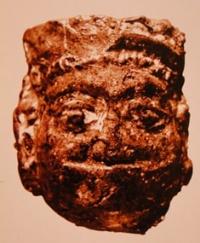You are here
Ancient settlement Kulan.

Excursion to the ancient settlement of Kulan.
“Kulan - a fortified city, a cathedral mosque in it (medina), lies on a large Taraz road”
Arab geographer al-Maksudi.
A trip from Taraz to of Kulan.
The complex of multi-time monuments is located on the territory and near the village of Kulan, Ryskulovsky district, Zhambyl region. It was a medieval city with a citadel surrounded by a moat. His archaeological research began in the XIXth century.
They revealed 3 cultural layers - from the VIIth to the XIIIth century. The palace complex of the Kulan settlement was located on an area of 2.2 square kilometers. The main raw material for the construction of buildings was unburnt clay.
It served as a binder for bricks, was used for plastering walls, coating floors. Burnt bricks began to be used only in the 11th century. The buildings were erected on a hill, on a cleared site without a foundation. During the excavation, 4 terracotta heads were found that were repelled from the torsos.
Facial expressions indicate that the statues were made from the main members of the local dynasty. Fragments of statues date back to the 9th century. They also found a bronze cauldron dating back to the 8th century, jugs and hums for storing wine and grain, as well as parts of a grape processing workshop.
The monument is on the UNESCO list. This is the only palace complex in Kazakhstan of this scale. However, after seasonal excavation is not guarded. For the first time Kulan is mentioned in the sources of the VII century.
Chinese pilgrim Xuan - Jiang. In the VIII - X century it is reported by Arab authors characterizing the cities located on the Great Silk Road. Arab geographer al - Maksidi reports that Kulan is a fortified city, there is a cathedral mosque, the city lies on a large Taraz road.
The town of Kulan was known as "a town on the border of the country of Turks on the side of Maverannahr." A number of famous historical events were associated with Kulan. So, here in 740 the last West - Turkic kagan Ashina Son was killed.
In the topography of the settlement, Shahristan, the citadel and traces of unreinforced slave from the east are traced. Outside, the settlement is surrounded by a moat, which has preserved a depth of about 1 m., A width of 15 m.
A rural district with an area of 12-15 square meters adjoined the settlement. km, surrounded by a rampart. The citadel was in the northwest corner. Currently, it is a high, quadrangular in plan hill with a platform on top.
All corners were fortified by towers. Rounded elevations are traced. Archaeological research has revealed 3 cultural layers: VII - VIII centuries, IX - X centuries, XI - XII centuries. During archaeological work on Kulan, a unique palace of the Karluk ruler with a very interesting architectural solution was discovered.
If until today, mostly carved or flat terracottas have been discovered during excavations, the Kulan finds are raw bricks with numerous patterns. The remains of the Kulan settlement indicate that the medieval city was one of the centers of craft and trade on the Great Silk Road.
In the course of archaeological research of the “temple complex” (2006), a rich and interesting collection of ceramics was collected on the site: boilers, jugs, mugs, humas, censers, and coffins.
Authority:
Margulan A. Kh., Basenov T., Mendikulov M. “Architecture of Kazakhstan”. Alma-Ata, 1959, pp. 94 - 96.
Photo
Alexander Petrov.







